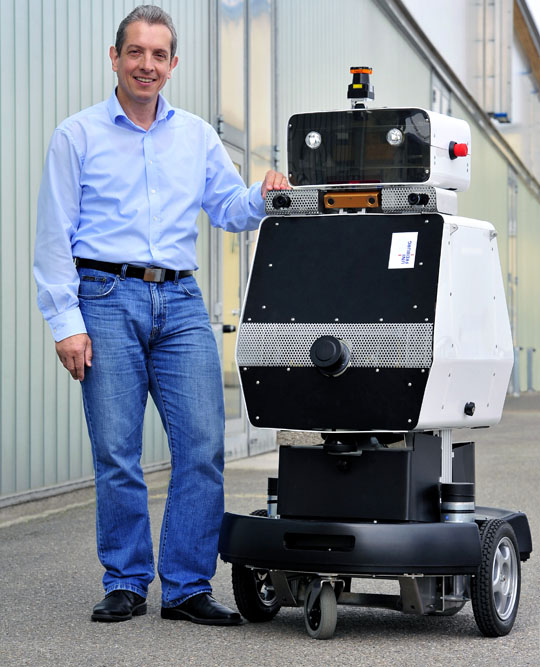Humans learn – machines do, too
Freiburg, Nov 20, 2017
University of Freiburg computer science professor Wolfram Burgard and his robots have already drawn a great deal of media attention. Obelix 2012 got a lot of looks as he rolled along through downtown Freiburg all by himself. He easily made his way from the Faculty of Engineering to the Bertoldsbrunnen. At first, it’s not apparent how much research effort and detail work are involved in such a project. Autonomous systems based on artificial intelligence (AI) are becoming increasingly significant in many areas of life. Research in this field is being promoted intensively. Wolfram Burgard had already received an ERC Advanced Grant in 2010. He used it to develop a method the robot could use to navigate more reliably. To mark the tenth anniversary of the ERC grant and its fifty recipients, the University of Freiburg is taking a look at selected projects that the grant has financed. A series features portraits of ten of the researchers who’ve received them.
 Obelix and his creator: “It’s just a whole lot of fun to program something that works in the real world,” says Wolfram Burgard.
Obelix and his creator: “It’s just a whole lot of fun to program something that works in the real world,” says Wolfram Burgard.
Photo: Thomas Kunz
“Back then the ERC grant almost seemed to be a bit too much for me,” admits Wolfram Burgard with the wink of an eye. Just before receiving it, he had won the Gottfried Wilhelm Leibniz Prize. And rationally and effectively deploying and administering research funding is a lot of work. The researcher had 2.5. Million euros available to him for five years. “The aim of our LiveNav project was to have a robot make its own way around Schauinsland along forest paths,” the scientist explains. Together with his team, Burgard developed processes to make robot navigation more reliable. In 2015, an intelligent off-road machine drove itself from the parking lot of the “Bergstation” to the observation tower at the summit.
But the trip there was rough, in more than just a literal sense. The foundation for the system is a map that the robot must learn in order to be able to orient itself in its surroundings. With many cameras, ultrasound, and laser sensors, the machine continually takes in its environment in order to determine its position. “The problem is that the world changes continually,” says Burgard. The robot fundamentally has problems recognizing things. That, says Burgard, makes the map less reliable and less useful. To ensure that the robot actually recognizes its environment, in must be equipped with an enormous amount of image data. Thousands upon thousands of pictures of the route on Schauinsland were taken and stored. They showed the surroundings in different seasons, at varying times of day and from changed perspectives.
Good hypotheses are keepers
“The robot continually tests every hypothesis to determine how well it fits with the measurements on the map. During this process, the good hypotheses multiply and the poor ones die out. Yet achieving that involves lots of statistics and complex algorithms that were developed by Burgard and his team. These can be used to classify the surroundings relatively precisely. Or to put it another way, the surroundings become readable and recognizable for the robot. Nevertheless, the robot kept getting lost. Yet all the while, it was able to keep learning – as long as its creators thoroughly assessed what was going wrong. “We looked very closely at why and which places it went the wrong way. Then we would provide additional image material that was missing, for example,” explains Burgard. It could be, continues the researcher, that in a winter view, a certain position was missing, therefore causing Obelix to lose orientation.
For computer scientist Wolfram Burgard, robots are the ideal research area. “It’s just a whole lot of fun to program something that works in the real world,” he says. He started out in software technology. When during the course of his work he came into contact with robots, everything clicked immediately and Burgard switched disciplines. In the meantime, he’s racked up a number of successes. “The processes that we’ve developed are still the gold standard today,” he says. Many automobile companies and suppliers use his algorithms for making advances in the area of self-driving vehicles. The maps developed for the robots determine position more precisely than GPS. The self-driving Google-car also orients itself with maps like these.
Burgard’s scientific vision is, however, that autonomous systems actually learn to navigate without maps. The watchword here is “deep learning.” Here, neural networks provide the model. The robot is to learn to translate the data that it receives from its sensors directly into action. When it comes to this technology, Wolfram Burgard and his team still have a long way to go. A further ERC grant would certainly help him along the route.
Petra Völzing

